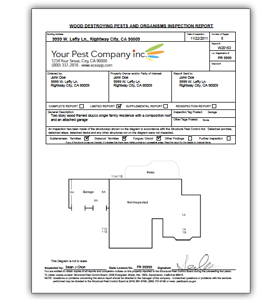When it comes to “Pest Inspections” there are some myths and misunderstandings even amongst realtors and industry experts. I always recommend getting a “whole-house inspection”. This is not to be confused with a pest inspection. Pest inspections are not always needed only when there is evidence of dry-rot or infestation. If the whole house inspector recommends getting a pest inspection, then of course, I would recommend one. In some cases, lenders require one especially if the loan is a VA loan.
Pest inspections within the real estate community does not include inspections for spiders, ants, mice or most other critters. A “pest inspection” is called “Wood Destroying Pest Inspection.” The purpose of these reports is to determine if there are termites or wood-boring beetle infestation. Pest inspectors will prepare a report that shows where the location of the infestation and/or dry rot. ( a copy is provided below) Dry rot is dampen wood that happens to be the favorite food for termites. P
A termite inspection is used to identify wood-destroying insects and wood rot. It also lists conditions that could lead to insect infestation or wood rot. It is also known as a pest inspection or W.D.O. inspection (wood destroying organism).
Top Ten Things you need to know about Termite Inspections
1. State Regulated
Termite companies are licensed by the California Pest Control Board. The Board was created by the pest control industry to ensure consumers are protected from fraud and unsafe pesticide applications. If a problem comes up that you cannot resolve directly with the termite company, the Board is here for you.
2. Estimates are Included
Unlike home inspections, termite reports include costs to treat termite activity and fix any damage. This makes it a useful property evaluation tool and explains why many lenders require a termite clearance before funding a home loan. It is common for older houses to need some repairs, even if they’ve been well maintained.
3. You Can Shop Around
If you need a termite clearance, all the wood damage and pest activity must be addressed. But only pesticide application and fumigation must be done by a licensed termite company. Most of the other items identified in termite reports are the result of moisture: rain, plumbing leaks, roof leaks and sprinklers. The usual fix requires replacing the damaged wood members. This could include siding, trim, flooring, doors, windows, and even more extensive work in/around bathrooms and crawlspaces. There are contractors who know how to repair wood damage and who could provide a bid based on the inspection report. Or, if you’re handy, you could do the repairs yourself. Many realtors/buyers hire us because they have crews who can complete repairs quickly. Most companies guarantee both our reports and any repairs. However, if the cost runs into thousands of dollars, I recommend getting a 2nd or 3rd quote. You do not have to use the pest company for the repairs however, to provide a clear report the same pest company must come out and inspect the work completed.
Reports expire in Four months.

Termite reports have a foundation diagram with locations of any infested problem areas. When doing a complete report, the inspector will look at the exterior, interior, and attic of the home. When looking at a house built on a raised foundation with a crawlspace beneath the bottom floor, the inspector will also check the crawlspace. The report includes assessment of numerous building components, including foundation walls and footings, porches, patios and steps, air vents, abutments, attic spaces, roof eaves, rafters, fascias, exposed timbers, exposed sheathing, ceiling joists, and attic walls.
The report also identifies conditions usually deemed likely to lead to infestation or infection, such as earth-wood contacts, excessive cellulose debris, faulty grade levels, excessive moisture conditions, evidence of roof leaks, and insufficient ventilation.
Preparing for a Termite Inspection
The inspector will need to get into to every part of the building, including areas you may not normally need to access. Every room is inspected including bedrooms, bathrooms, closets, and garages. Here are some tips to help ensure the most complete inspection report:
- Remove or secure any pets.
- Clear stored personal property. Move items stored in the garage two feet away from the walls.
- Provide access to the subarea hatch. It is often located in a closet floor. Remove any property stored in this area.
- Clear access to attic and crawlspace hatches. Remove clothes beneath the attic access if it is in a closet.
Getting the Most Out of your Inspection
Most companies specialize in real estate inspections, so the customer is usually a home buyer or seller. Attending the inspection will give you valuable perspective and help you better understand the written report. After the inspector is done, he will point out any areas of concern and explain possible solutions.
The findings listed on the report are divided into Section 1, Section 2, and Further Inspection items. Section 1 items include areas where wood damage was noted, or where there are signs of active termites. Section 2 items include conditions that may lead to damage or termite activity if not addressed. Further inspection items include areas that were not accessible at the time of inspection. A Work Authorization is at the end of the report. It lists costs for the correction of any findings. The costs can be varied from a few hundred dollars to many thousands. This cost is usually bore by the Seller but it is always negotiable between buyers and sellers.
I trust this helps de-mystify the pest inspection and should you have any questions or comments please call or drop me an email.
John Ecklein, Realty ONE Group/Complete
916-308-7642 email: john.ecklein@gmail.com

